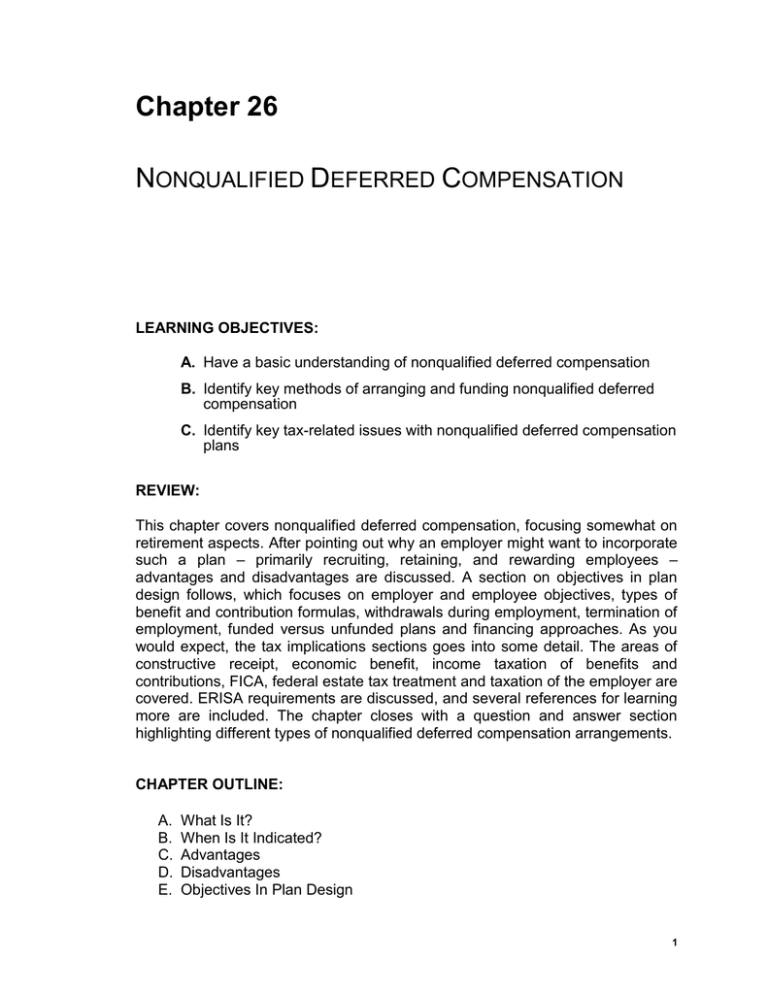Chapter 26 N D C
advertisement

Chapter 26 NONQUALIFIED DEFERRED COMPENSATION LEARNING OBJECTIVES: A. Have a basic understanding of nonqualified deferred compensation B. Identify key methods of arranging and funding nonqualified deferred compensation C. Identify key tax-related issues with nonqualified deferred compensation plans REVIEW: This chapter covers nonqualified deferred compensation, focusing somewhat on retirement aspects. After pointing out why an employer might want to incorporate such a plan – primarily recruiting, retaining, and rewarding employees – advantages and disadvantages are discussed. A section on objectives in plan design follows, which focuses on employer and employee objectives, types of benefit and contribution formulas, withdrawals during employment, termination of employment, funded versus unfunded plans and financing approaches. As you would expect, the tax implications sections goes into some detail. The areas of constructive receipt, economic benefit, income taxation of benefits and contributions, FICA, federal estate tax treatment and taxation of the employer are covered. ERISA requirements are discussed, and several references for learning more are included. The chapter closes with a question and answer section highlighting different types of nonqualified deferred compensation arrangements. CHAPTER OUTLINE: A. B. C. D. E. What Is It? When Is It Indicated? Advantages Disadvantages Objectives In Plan Design 1 Chapter 26 F. G. H. I. J. 1. Employer Objectives 2. Employee Objectives 3. Types of Benefit and Contribution Formulas 4. Withdrawals During Employment 5. Termination of Employment 6. Funded versus Unfunded Plans 7. Financing Approaches Tax Implications 1. Constructive Receipt 2. Economic Benefit 3. Income Taxation of Benefits and Contributions 4. Social Security (FICA) Taxes 5. Federal Estate Tax Treatment 6. Taxation of the Employer ERISA Requirements Where Can I Find Out More About It? Questions And Answers Chapter Endnotes FEATURED TOPICS: Nonqualified deferred compensation Types of benefits and contribution formulas: salary continuation formula, salary reduction formula, excess benefit plan, stock appreciations rights and phantom stock formulas Financing approaches: reserve account maintained by employer, employer reserve account with employee investment direction, corporate-owned life insurance, Rabbi trust, third-party guarantees Nonqualified deferred compensation taxation issues FIGURES: Figure 26.1 Nonqualified deferred compensation Design Worksheet Figure 26.2 Alternative Reporting and Disclosure Statement For Unfunded Nonqualified Deferred Compensation Plans For Certain Selected Employees Figure 26.3 Years Until Break Even For Deferred Compensation Assuming Tax Rates Will Increase And Current Rate is 28% or 33% Figure 26.4 IRS Model Rabbi Trust Sample Document Chapter 26 CFP® CERTIFICATION EXAMINATION TOPIC: Topic 61: Types of retirement plans A. Characteristics 2) Non-qualified plans Topic 33: Non-qualified deferred compensation . A. Basic provisions and differences from qualified plans B. Types of plans and applications C. Income tax implications D. Funding methods E. Strategies COMPETENCY: Upon completion of this chapter, the student should be able to: 1. Have a basic understanding of nonqualified deferred compensation 2. Identify key methods of arranging and funding nonqualified deferred compensation 3. Identify key tax-related issues with nonqualified deferred compensation plans KEY WORDS: nonqualified deferred compensation, key employee, salary continuation formula, corporate-owned life insurance (COLI), salary reduction formula, excess benefit plan, stock appreciation right (SAR), phantom stock formula, accelerated distribution, haircut provisions, funded plan, unfunded plan, reserve account, rabbi trust, third-party guarantees, constructive receipt, economic benefit, secular trust DISCUSSION: 1. Discuss when it would be appropriate to implement a nonqualified deferred compensation plan, and what benefits would be achieved by doing so. 2. Discuss similarities and differences between the different approaches to nonqualified deferred compensation plan funding and benefits. Chapter 26 QUESTIONS: 1. Which of the following benefits are usually created with nonqualified deferred compensation plans? (1) “up front” income tax deduction for employer (2) tax deferral for employee (3) “back end” tax deduction for employer (4) tax deduction for employee a. b. c. d. (1) and (2) only (1) and (3) only (2) and (3) only (3) and (4) only Chapter 26, p. 220 2. Which of the following plan types relates best to this plan description: “At retirement, disability, or death, the XYZ Corporation will pay you or your designated beneficiary $50,000 a year for 10 years starting at age 65”? a. b. c. d. salary continuation formula salary reduction formula excess benefit plan phantom stock formula Chapter 26, p. 222 3. Which of the following is a major concern for allowing withdrawals of deferred compensation amounts during employment? a. b. c. d. de minimis cashouts constructive receipt doctrine salary reduction excess benefits Chapter 26, p. 224 4. Which of the following are situations or reasons for using a rabbi trust? (1) owner-employee wants to establish a qualified retirement plan (2) fear that business ownership might change prior to benefits being paid (3) new management might be hostile to the key employee and fail to honor its obligation to pay Chapter 26 (4) litigation to enforce payment is too costly a. b. c. d. (1) and (3) only (2) and (4) only (1) (2) and (3) only (2) (3) and (4) only Chapter 26, pp. 234-35 ANSWERS: 1. c 2. a 3. b 4. d
